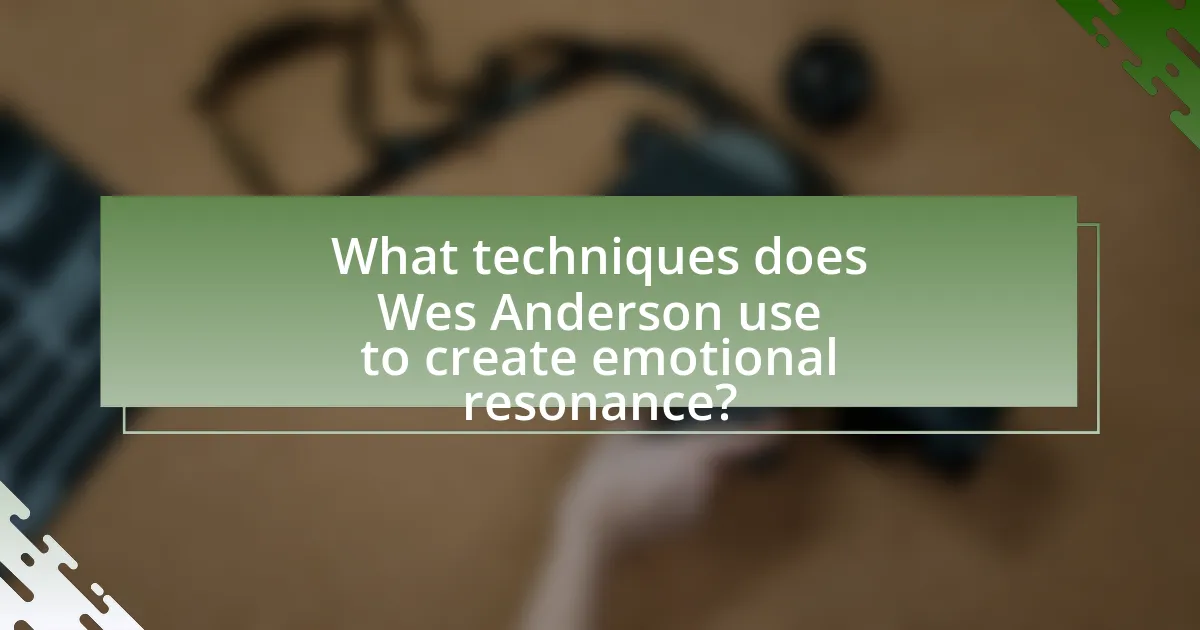The article focuses on the aesthetic of Wes Anderson’s films, highlighting key elements such as symmetrical compositions, vibrant color palettes, and meticulous set designs that create a whimsical and nostalgic atmosphere. It explores the role of color in establishing mood and character development, the significance of symmetry in cinematography, and the impact of set design and props on storytelling. Additionally, the article examines recurring themes in Anderson’s work, including family dynamics and nostalgia, and discusses how humor and music contribute to emotional resonance. Overall, it provides a comprehensive analysis of the visual and narrative techniques that define Anderson’s unique cinematic style.
What defines the aesthetic of Wes Anderson’s films?
The aesthetic of Wes Anderson’s films is defined by their distinctive visual style, characterized by symmetrical compositions, vibrant color palettes, and meticulous attention to detail. Anderson employs a unique blend of whimsical and nostalgic elements, often incorporating vintage props and settings that evoke a sense of timelessness. His films frequently feature a specific type of storytelling that combines deadpan humor with emotional depth, creating a surreal yet relatable atmosphere. The use of carefully curated soundtracks, often featuring classic songs, further enhances the overall aesthetic, reinforcing the emotional tone of the narrative.
How does color play a role in Wes Anderson’s visual style?
Color is a fundamental element in Wes Anderson’s visual style, serving to create distinct moods and enhance storytelling. His films often feature a carefully curated color palette, characterized by pastel shades and vibrant hues that evoke specific emotions and themes. For instance, the use of warm colors in “The Grand Budapest Hotel” reflects nostalgia and warmth, while cooler tones in “Moonrise Kingdom” convey a sense of innocence and adventure. This intentional color selection not only establishes a unique visual identity but also reinforces character development and narrative arcs, as seen in the contrasting colors that represent different characters’ personalities and journeys. Anderson’s meticulous attention to color contributes significantly to the overall aesthetic coherence of his films, making them instantly recognizable and emotionally resonant.
What are the predominant color palettes used in his films?
Wes Anderson’s films predominantly utilize pastel color palettes characterized by soft pinks, muted greens, and light blues. This distinctive use of color creates a whimsical and nostalgic atmosphere, enhancing the storytelling and visual appeal. For example, in “The Grand Budapest Hotel,” the color scheme features vibrant pinks and purples, which contribute to the film’s fairy-tale quality and emotional depth. Anderson’s meticulous attention to color not only defines the aesthetic of his films but also reinforces themes of nostalgia and surrealism, making the color palettes integral to his cinematic style.
How do color choices influence the mood and tone of the films?
Color choices significantly influence the mood and tone of films by evoking specific emotional responses and setting the overall atmosphere. For instance, warm colors like reds and yellows can create feelings of warmth and happiness, while cool colors such as blues and greens often evoke calmness or sadness. In Wes Anderson’s films, the use of pastel colors contributes to a whimsical and nostalgic tone, enhancing the storytelling and character development. Research indicates that color psychology plays a crucial role in film, as studies show that viewers associate certain colors with particular emotions, thereby affecting their perception of the narrative.
What is the significance of symmetry in Wes Anderson’s cinematography?
Symmetry in Wes Anderson’s cinematography is significant because it creates a visually striking and harmonious aesthetic that enhances storytelling. This deliberate use of symmetry allows for a sense of balance and order, which reflects the themes of nostalgia and whimsy prevalent in his films. For instance, in “The Grand Budapest Hotel,” symmetrical framing is employed to emphasize the meticulousness of the hotel’s architecture and the characters’ lives, reinforcing the film’s narrative structure. This technique not only captivates the audience but also serves to evoke emotional responses, making the viewing experience more immersive and engaging.
How does symmetry contribute to the storytelling in his films?
Symmetry in Wes Anderson’s films enhances storytelling by creating a visually striking and balanced composition that reflects the emotional states of characters and the narrative’s themes. This deliberate use of symmetry often signifies order amidst chaos, allowing viewers to engage more deeply with the story’s underlying messages. For instance, in “The Grand Budapest Hotel,” symmetrical framing emphasizes the meticulousness of the hotel’s environment, mirroring the protagonist’s quest for order in a tumultuous world. This visual technique not only captivates the audience but also reinforces character dynamics and plot progression, making the storytelling more impactful.
What are some iconic examples of symmetry in specific films?
Iconic examples of symmetry in specific films include Wes Anderson’s “The Grand Budapest Hotel,” where meticulously balanced compositions create a visually striking aesthetic. The film features symmetrical framing in scenes such as the hotel lobby and the train sequences, emphasizing order and harmony. Another example is “Moonrise Kingdom,” which showcases symmetrical shots of the island and the characters’ camps, reinforcing the whimsical and structured nature of the narrative. Additionally, “The Royal Tenenbaums” employs symmetry in the family home’s layout and character placements, enhancing the film’s themes of nostalgia and family dynamics. These films exemplify Anderson’s signature style, where symmetry serves to create a unique visual storytelling experience.
How does Wes Anderson utilize set design and props?
Wes Anderson utilizes set design and props to create meticulously crafted visual worlds that enhance storytelling and evoke specific emotions. His films often feature symmetrical compositions, vibrant color palettes, and distinctive, whimsical details that contribute to a unique aesthetic. For instance, in “The Grand Budapest Hotel,” the elaborate hotel set and carefully chosen props, such as the ornate lobby and vintage luggage, establish a nostalgic atmosphere and reflect the film’s themes of memory and loss. Anderson’s attention to detail in set design and props not only serves to immerse viewers in his fantastical narratives but also reinforces character development and thematic depth, as seen in the contrasting environments of “Moonrise Kingdom,” where the natural landscape juxtaposes the structured, artificial elements of the children’s camp.
What are the common themes found in his set designs?
Common themes found in Wes Anderson’s set designs include symmetry, vibrant color palettes, and meticulous attention to detail. His sets often feature a whimsical, storybook quality that enhances the narrative, utilizing bold colors and patterns to create visually striking environments. Additionally, Anderson frequently incorporates nostalgic elements and a sense of playfulness, reflecting a blend of childhood innocence and adult themes. These design choices are evident in films like “The Grand Budapest Hotel,” where the intricate set design serves to establish the film’s unique tone and atmosphere.
How do props enhance character development and narrative?
Props enhance character development and narrative by serving as tangible extensions of a character’s personality and motivations. In Wes Anderson’s films, props often reflect the inner lives of characters, providing visual cues that deepen audience understanding. For example, in “The Royal Tenenbaums,” the unique items in the Tenenbaum household, such as Margot’s playwriting materials and Richie’s tennis gear, symbolize their individual struggles and aspirations. This use of props not only enriches the narrative but also allows viewers to connect emotionally with the characters, as these objects often carry personal histories and significance. Thus, props function as critical narrative devices that enhance both character depth and storytelling in Wes Anderson’s cinematic style.
What are the recurring themes in Wes Anderson’s films?
Recurring themes in Wes Anderson’s films include family dynamics, nostalgia, and the exploration of individuality versus conformity. Family dynamics often manifest through complex relationships, as seen in “The Royal Tenenbaums,” where familial dysfunction drives the narrative. Nostalgia is prevalent in the visual style and storytelling, evoking a sense of longing for the past, exemplified in “Moonrise Kingdom,” which captures the innocence of childhood. The tension between individuality and conformity is highlighted in characters who struggle to find their identity within societal expectations, as portrayed in “The Life Aquatic with Steve Zissou.” These themes are consistently woven throughout his body of work, reinforcing his unique cinematic style.
How does nostalgia manifest in his storytelling?
Nostalgia manifests in Wes Anderson’s storytelling through his use of whimsical visuals, retro aesthetics, and emotionally resonant themes. His films often feature meticulously crafted sets and color palettes that evoke a sense of longing for a bygone era, such as the pastel colors and vintage props in “The Grand Budapest Hotel.” Additionally, Anderson incorporates elements of childhood innocence and familial relationships, as seen in “The Royal Tenenbaums,” where the characters’ pasts are intricately woven into their present struggles, creating a bittersweet reflection on memory and loss. This combination of visual style and thematic depth reinforces the nostalgic atmosphere that permeates his work.
What elements evoke a sense of nostalgia in his narratives?
Wes Anderson’s narratives evoke a sense of nostalgia through elements such as meticulous set design, vintage aesthetics, and the use of childhood themes. The detailed and often whimsical environments in his films, like the pastel colors and symmetrical compositions, create a visual style reminiscent of mid-20th century Americana. Additionally, Anderson frequently incorporates themes of family dynamics and lost innocence, which resonate with viewers’ own memories of childhood. For instance, in “The Royal Tenenbaums,” the portrayal of a dysfunctional family grappling with their past elicits a longing for simpler times. These elements collectively foster a nostalgic atmosphere that connects audiences to their own experiences and memories.
How does nostalgia affect audience perception of his films?
Nostalgia significantly enhances audience perception of Wes Anderson’s films by evoking emotional connections to past experiences and cultural references. This emotional resonance is achieved through Anderson’s distinctive visual style, characterized by symmetrical compositions, vibrant color palettes, and meticulous set designs that often reflect mid-20th century aesthetics. Research indicates that nostalgia can increase feelings of warmth and belonging, which in turn makes audiences more receptive to the themes and narratives presented in his films. For instance, studies have shown that nostalgic feelings can lead to greater enjoyment and appreciation of media, as viewers often associate Anderson’s work with a sense of comfort and familiarity, thereby deepening their engagement with the story and characters.
What role do family dynamics play in his films?
Family dynamics are central to Wes Anderson’s films, often serving as a lens through which themes of love, conflict, and identity are explored. In films like “The Royal Tenenbaums” and “The Darjeeling Limited,” the intricate relationships among family members highlight both dysfunction and affection, illustrating how these dynamics shape individual characters’ journeys. For instance, “The Royal Tenenbaums” showcases a family of prodigies grappling with their father’s neglect, which drives the narrative and character development. This focus on familial relationships not only adds emotional depth but also reflects Anderson’s own experiences and observations of family life, making the portrayal relatable and poignant.
How are family relationships portrayed in his narratives?
Family relationships in Wes Anderson’s narratives are portrayed as complex and often dysfunctional, highlighting themes of estrangement, loyalty, and reconciliation. For instance, in “The Royal Tenenbaums,” the dynamics between the Tenenbaum family members reveal deep-seated resentments and unfulfilled expectations, yet they also showcase moments of vulnerability and connection. This duality illustrates how familial bonds can be both a source of pain and a pathway to healing, as characters navigate their shared history and individual struggles. Anderson’s use of visual symmetry and meticulous framing further emphasizes these relationships, creating a distinct aesthetic that mirrors the emotional intricacies of family life.
What impact do these dynamics have on character arcs?
The dynamics in Wes Anderson’s films significantly shape character arcs by emphasizing individuality and emotional depth. Characters often undergo transformations that reflect their unique quirks and relationships, leading to profound personal growth or realization. For instance, in “The Royal Tenenbaums,” the interplay of familial dysfunction and personal ambition drives characters like Richie and Margot to confront their pasts, ultimately leading to a deeper understanding of themselves and their connections. This narrative structure illustrates how the dynamics of relationships and personal struggles are integral to character development, showcasing the impact of these elements on their arcs.
How does humor function within the aesthetic of his films?
Humor in Wes Anderson’s films functions as a critical element that enhances the overall aesthetic by juxtaposing whimsical visuals with poignant themes. This blend creates a unique emotional resonance, allowing audiences to engage with complex narratives while enjoying lighthearted moments. For instance, the use of deadpan delivery and absurd situations often highlights the characters’ quirks, making their emotional struggles more relatable. The meticulous composition and vibrant color palettes further amplify this humor, as seen in films like “The Grand Budapest Hotel,” where comedic elements are seamlessly integrated into the visual storytelling, reinforcing the film’s themes of nostalgia and loss.
What types of humor are prevalent in his storytelling?
Wes Anderson’s storytelling prominently features deadpan humor, absurdity, and whimsical irony. Deadpan humor is characterized by a straight-faced delivery of comedic lines, often contrasting with the absurd situations presented, which creates a unique comedic effect. Absurdity in his narratives often involves surreal scenarios and exaggerated characters, leading to unexpected and humorous outcomes. Whimsical irony is evident in the juxtaposition of serious themes with lighthearted dialogue and situations, allowing for a playful exploration of complex emotions. These humor types are consistently observed across his films, such as “The Royal Tenenbaums” and “Moonrise Kingdom,” where the blend of these elements contributes to the distinctive charm and aesthetic of his work.
How does humor contribute to the overall tone of his films?
Humor significantly contributes to the overall tone of Wes Anderson’s films by creating a whimsical and often surreal atmosphere that balances emotional depth with lightheartedness. This unique blend allows audiences to engage with complex themes, such as family dynamics and existentialism, while maintaining an accessible and entertaining experience. For instance, the use of deadpan delivery and absurd situations in films like “The Royal Tenenbaums” and “Moonrise Kingdom” enhances the comedic elements, making poignant moments more relatable and impactful. This strategic incorporation of humor not only defines Anderson’s distinctive style but also reinforces the emotional resonance of his narratives, allowing viewers to navigate serious topics with a sense of levity.

What techniques does Wes Anderson use to create emotional resonance?
Wes Anderson creates emotional resonance through meticulous visual composition, character-driven narratives, and the use of nostalgia. His films often feature symmetrical framing and vibrant color palettes, which establish a distinct aesthetic that draws viewers in emotionally. Character-driven narratives, such as those in “The Royal Tenenbaums” and “Moonrise Kingdom,” explore complex familial relationships and personal struggles, allowing audiences to connect deeply with the characters’ journeys. Additionally, Anderson employs nostalgic elements, such as vintage music and retro settings, which evoke a sense of longing and familiarity, further enhancing the emotional impact of his storytelling.
How does music enhance the emotional depth of his films?
Music enhances the emotional depth of Wes Anderson’s films by creating a distinct atmosphere that complements the visual storytelling. The carefully curated soundtracks often feature a mix of classic and contemporary songs, which evoke specific feelings and nostalgia, thereby deepening the audience’s emotional connection to the characters and narrative. For instance, the use of songs by composers like Alexandre Desplat and iconic tracks from artists such as David Bowie and The Kinks not only sets the tone but also reinforces the themes of longing and whimsy prevalent in his work. This strategic integration of music has been shown to significantly influence viewer perception and emotional response, as evidenced by studies indicating that soundtracks can enhance emotional engagement by up to 50%.
What are some notable soundtracks and their impact on storytelling?
Notable soundtracks significantly enhance storytelling by establishing mood, character development, and thematic depth. For instance, the soundtrack of “The Royal Tenenbaums,” featuring songs by Elliott Smith, underscores the film’s themes of nostalgia and melancholy, effectively mirroring the characters’ emotional states. Similarly, “Moonrise Kingdom” utilizes a score by Alexandre Desplat, which complements the whimsical narrative and highlights the innocence of young love, thereby enriching the viewer’s emotional experience. These soundtracks not only support the visual elements but also deepen the audience’s connection to the story, demonstrating the integral role music plays in cinematic storytelling.
How does the choice of music reflect character emotions?
The choice of music in Wes Anderson’s films reflects character emotions by using specific soundtracks that align with the characters’ psychological states. For instance, the use of melancholic tunes often accompanies scenes of introspection or sadness, highlighting the characters’ inner turmoil. In “The Royal Tenenbaums,” the song “Hey Jude” underscores a moment of vulnerability, enhancing the emotional depth of the scene. This strategic selection of music not only amplifies the emotional resonance but also provides insight into the characters’ experiences, making the audience more empathetic towards their struggles.
What narrative structures are commonly found in his films?
Wes Anderson’s films commonly utilize a non-linear narrative structure, characterized by fragmented timelines and multiple storylines that converge. This approach allows for a rich exploration of themes such as family dynamics and nostalgia, often presented through a whimsical lens. For instance, in “The Royal Tenenbaums,” the narrative unfolds through a series of flashbacks that reveal the characters’ backstories, enhancing the emotional depth of the film. Additionally, Anderson frequently employs a storybook format, where the narrative is divided into chapters, as seen in “The Grand Budapest Hotel,” which further emphasizes the stylized and theatrical nature of his storytelling.
How do these structures affect audience engagement?
The structures in Wes Anderson’s films significantly enhance audience engagement by creating a unique visual and narrative style that captivates viewers. These structures, characterized by symmetrical compositions, vibrant color palettes, and meticulous set designs, draw the audience into a whimsical world that feels both familiar and surreal. Research indicates that such aesthetic choices can evoke emotional responses, making viewers more invested in the characters and storylines. For instance, a study published in the Journal of Visual Culture highlights how symmetry in film composition can lead to increased viewer satisfaction and emotional connection, reinforcing the effectiveness of Anderson’s stylistic choices in engaging his audience.
What are the implications of non-linear storytelling in his work?
Non-linear storytelling in Wes Anderson’s work enhances thematic depth and character development. By presenting events out of chronological order, Anderson allows viewers to engage with the narrative in a more interactive manner, prompting them to piece together the story and its emotional resonance. This technique often emphasizes the subjective nature of memory and perception, as seen in films like “The Royal Tenenbaums,” where fragmented timelines reflect the characters’ complex relationships and personal histories. Such storytelling invites audiences to explore multiple perspectives, enriching their understanding of the characters and the overarching themes of nostalgia and loss.
What can viewers learn from the aesthetic of Wes Anderson’s films?
Viewers can learn that the aesthetic of Wes Anderson’s films emphasizes symmetry, vibrant color palettes, and meticulous set design. This distinctive visual style creates a whimsical and nostalgic atmosphere, allowing audiences to engage with the narrative on a deeper emotional level. For instance, films like “The Grand Budapest Hotel” showcase meticulously crafted environments that reflect the characters’ inner lives, reinforcing themes of nostalgia and loss. Anderson’s use of color, such as the pastel hues in “Moonrise Kingdom,” further enhances the emotional resonance of the story, illustrating how visual elements can significantly impact storytelling.
How can aspiring filmmakers apply his techniques in their own work?
Aspiring filmmakers can apply Wes Anderson’s techniques by incorporating his distinctive visual style, narrative structure, and character development into their own projects. They can achieve this by using symmetrical compositions, vibrant color palettes, and meticulous set designs that create a whimsical atmosphere, similar to Anderson’s films like “The Grand Budapest Hotel.” Additionally, filmmakers can adopt his storytelling approach, which often features quirky characters and deadpan humor, to enhance their narratives. By studying Anderson’s use of music and sound design, filmmakers can also learn to create emotional resonance and enhance the overall viewing experience.
What are some best practices for analyzing film aesthetics inspired by his style?
To analyze film aesthetics inspired by Wes Anderson’s style, focus on key elements such as color palettes, symmetry, and meticulous set design. Anderson’s films often feature vibrant, pastel colors that create a whimsical atmosphere, which can be examined through color theory to understand emotional impact. Additionally, his use of symmetry in framing and composition enhances visual storytelling, making it essential to analyze shot composition and camera angles. Furthermore, the detailed set design, often resembling dioramas, invites viewers to explore the narrative context and character development, thus requiring a close examination of props and background elements. These practices allow for a comprehensive understanding of how Anderson’s unique aesthetic contributes to the overall narrative and emotional resonance of his films.




